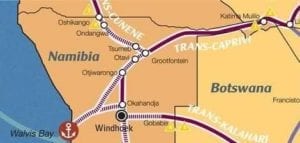The opening of the Katima-Sheseke Bridge along the Walvis Bay-Ndola-Lubumbashi Development Corridor (WBNLDC) 11 years ago has enhanced trade between Namibia and Zambia and has increased the role of Namibia as a gateway to its landlocked neighbours: Zambia, Zimbabwe and the Democratic Republic of Congo.
Using the Port of Walvis Bay and the road and rail network, the WBNLDC continues to provide an additional safe and reliable trade route for both Zambia and Southern DRC, in addition to serving Malawi. Prior to the opening of the bridge, all imports and exports destined for these countries were transported via South Africa, Mozambique and Tanzania. As a country, Namibia has made significant strides in the context of trade routes and continues to attract more and more volumes which in turn relates to additional business activities along the WBNLDC. In addition to the potential catalyst for its own internal economy, the Walvis Bay Corridors have a significant impact on the economy of neighbouring countries by offering faster, safer and more cost-effective transit of goods.Commodities such as mining equipment, chemicals, copper, agricultural products, perishables and consumables like meat, chicken and fish are transported along the WBNLDC.
Trade along the WBNLDC does not only benefit Namibia, but the whole southern African region at large. The increased volumes and trucks on the road bring buying power in terms of goods and services. Looking to the future, the WBCG, together with relevant stakeholders who amongst others include the National Planning Commission (NPC), the Ministries of Industrialisation, Trade and SME Development, Works and Transport, Home Affairs, have embarked on the Namibia Logistics Hub Project which seeks to further enhance the current trade route offering and ultimately establish Namibia as the preferred Hub for Southern Africa.







